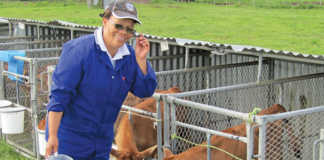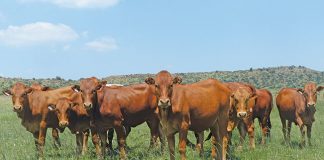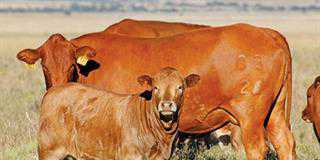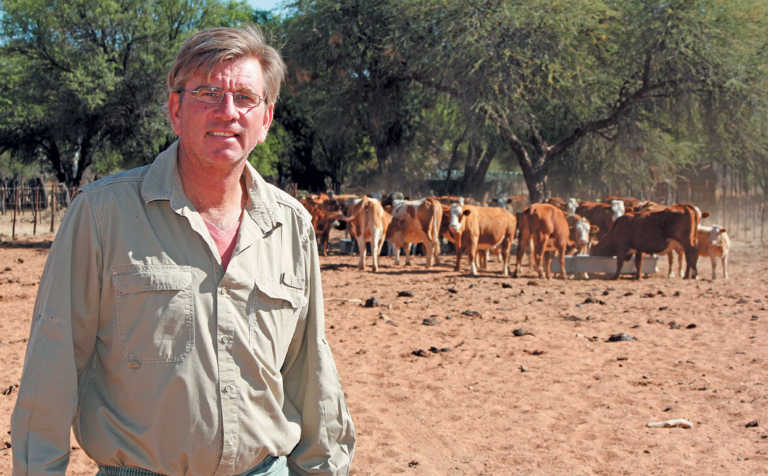
Photo: Wayne Southwood
René Krafft is the fourth generation family member to run one of Namibia’s oldest Simmentaler studs, Ibenstein, near Dordabis in Namibia.
His great-grandfather, August Stauch, arrived in Namibia in 1907 and imported Simmentaler cattle in the early 1920s. After the stud had been neglected for some time, René’s father, Michael Krafft, took over breeding operations in 1960, laying the foundation for today’s high-quality breeding herd, bred for African conditions.
His enterprise includes a game and safari business, the Ibenstein Simmentaler stud herd, and commercial Simmentaler X Brahman beef cattle. The average annual rainfall on the farm is 350mm, and the habitat is roughly divided into six biozones: open savanna, camel thorn forest, bush land, mountains, riverine areas, and mixed veld.
The most common grasses are Stipagrostis uniplumis, Cenchrus ciliaris and various Schmidia species. Black thorn Acacia mellifera encroachment is fast becoming a problem, but René says he has not yet had to implement a bush-clearing programme.
The farm is laid out in camps ranging in size between 60ha and 200ha, each with a watering point. Cows never have to walk more than 3km to reach water. The 120- cow stud has strong estimated breeding values (EBVs) for fertility, growth, udders and milk.
Why Simmentaler?
René grew up with Simmentaler cattle and says he has always had an affinity for them. According to him, the breed is very well adapted to Southern Africa, but it was initially assumed that an European breed would never last this long in an African country.
However, the breed has proven itself on the harsh Namibian terrain. What is more, it can be crossbred very well with other breeds such as the Brahman, he says.
Breeding
René says he aims to breed cows that wean excellent weaners on the veld. “It doesn’t help to have a beautiful cow if her calves don’t grow fast enough,” he explains.
He concentrates on establishing good muscling, milk and udder traits in the cow herd. “The more the milk, the better the calf,” he says.
The milk EBVs in the herd are already very high, but for better udder attachment and more fore udder he uses bulls from good udder lines. The herd’s fertility is excellent and the policy is that if a cow does not conceive, she is out, he explains.
René stresses that his crossbreeding clients like the fact that his herd has high EBVs for milk. This is to their advantage as his bulls will sire cows that produce higher volumes of milk in a commercial herd.
The average mature cow weighs 550kg, while the birth weight of heifers is between 35kg and 40kg, and bulls between 40kg and 45kg. At seven months, heifers are weaned at around 240kg and bull calves at about 260kg. Heifers are put to the bull at 18 months at a minimum weight of 350kg.
René uses the Herdmaster livestock management program, while the herd’s performance and characteristics are recorded and analysed by Breedplan. “This [system] shows which animals perform well, which to keep, and which I must get rid of,” he explains.
René sells some bulls off the farm, but retains the best to be sold at stud sales in Windhoek.
Replacement and culling
In 2012, he reduced the herd to the 60 very best cows, but in 2016, the herd was back to 120 cows and heifers.
About 20% of the mature cows are replaced with heifers every year.
Cows older than 10 years are generally culled due to tooth wear. However, the 12-year-old cow, Ibenstein Holle MK 04 140, is still on the farm and expecting her 12th calf. She is now fed out of a bag. With an ICP of 345 days, she is a Select Cow and dam of the current champion bull, Ibenstein Sojus MK13 08. René admits to being too attached to her to send her to the abattoir.
He first selects at weaning and sends the culls to local weaner sales, where most are destined for South African feedlots. The next selection takes place after the breed society inspector has classified them, and the third selection before mating. Low weaning weights and 400-day weights are the most common culling criteria.
René runs two breeding seasons, February to May and August to October. He artificially inseminates every heifer or cow that comes on heat during the first three weeks of a breeding season, before putting the bulls to the herd.
During the previous season, he used one bull from South Africa, three bulls from Europe, and semen from his own bulls.
One of the AI bulls are used for a day on any cow that comes on heat, as René wants to use these bulls on many different cows to obtain as much variation as possible and then compare the progeny.
He conducts pregnancy tests two months after removing the bulls from the herd. The conception rate in the herd is between 95% and 100%.
Although he tries to follow a specific grazing rotation pattern, René admits that under drought conditions this is very difficult. The carrying capacity of the farm varies from 15ha/MLU to 20ha/MLU.
Feeding regime
René has a veritable forest of camel thorn trees (Acacia erioloba) on his farm from which he has collected up to 30t of pods in one season. A total of 50ha of sour grass (Schmidtia kalahariensis) is cut and baled at about 1,3t/ ha (300 round bales).
These ingredients are hammer-milled and mixed with phosphate and molasses, and used as a homemade lick. Show cattle are boosted with brewer’s grain at 1kg/animal/day to get them into show condition.
Achievements
Last year was one of many achievements. Ibenstein Sojus MK13 08 was the Dual Purpose Bull Champion at three consecutive shows: Otjiwarongo, Gobabis and Windhoek.
Ibenstein Uta MK08 02 was crowned Breed Champion Cow and Select Cow. By the age of eight years and nine months this cow had had seven calves, the first when she was 35 months old.
Her 331-day ICP means that she had calved a month earlier every consecutive year. René says she is an amazingly feminine cow with good depth and capacity, good legs, feet and muscling.
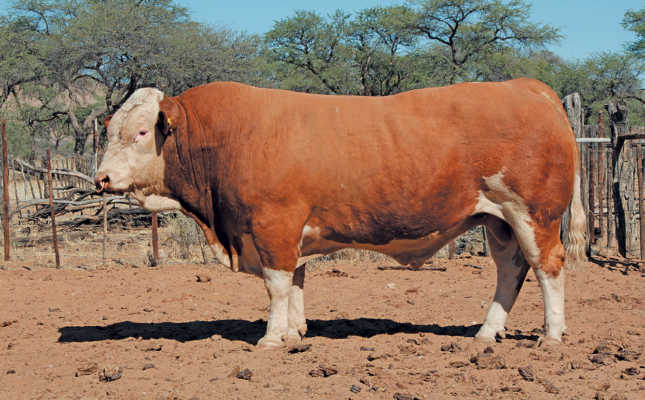
Although she has an udder that may be too large for extensive conditions, she certainly produces strong and healthy calves, he adds.
René also runs a 150-cow commercial Simmentaler X Brahman herd on his second farm, Protea (7 000ha), where he uses a two-way cross system, breeding cows according to phenotype: Bos indicus-type cows to Bos taurus bulls, and vice versa.
This herd is run purely to produce weaner calves, mostly sold to South African feedlots.
René says he will continue to maintain a strict selection policy for fertility and productivity to further improve his herd.
Phone René Krafft on +264 (0) 81 149 2535, or email [email protected].











